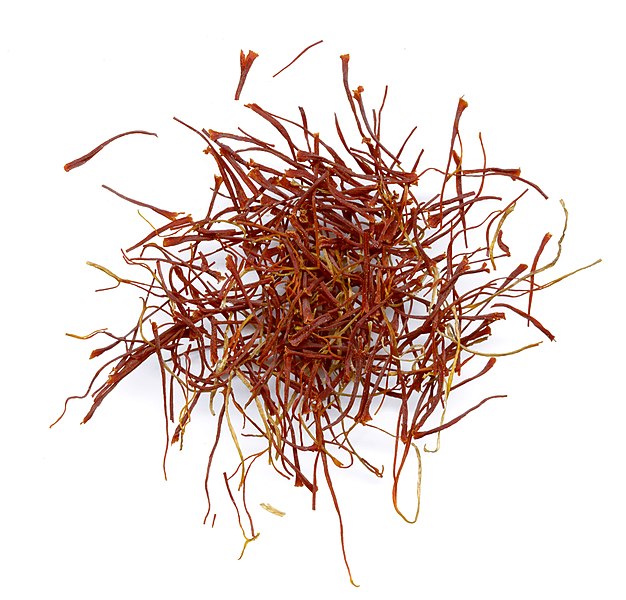Saffron
[size=75]From Wikipedia, the free encyclopedia [/size]
Saffron (pronounced /ˈsæfrən/, /ˈsæfrɒn/) is a spice derived from the flower of the saffron crocus (Crocus sativus), a species of crocus in the family Iridaceae. The flower has three stigmas, which are the distal ends of the plant’s carpels. Together with its style, the stalk connecting the stigmas to the rest of the plant, these components are often dried and used in cooking as a seasoning and colouring agent. Saffron, which has for decades been the world’s most expensive spice by weight,[1][2] is native to Southwest Asia.[2][3] It was first cultivated in the vicinity of Greece.[4]
Saffron is characterised by a bitter taste and an iodoform- or hay-like fragrance; these are caused by the chemicals picrocrocin and safranal.[5][6] It also contains a carotenoid dye, crocin, that gives food a rich golden-yellow hue. These traits make saffron a much-sought ingredient in many foods worldwide. Saffron also has medicinal applications.
The word saffron originated from the 12th-century Old French term safran, which derives from the Latin word safranum. Safranum is also related to the Italian zafferano and Spanish azafrán.[7] Safranum comes from the Arabic word aṣfar (أَصْفَر), which means “yellow,” via the paronymous zaʻfarān (زَعْفَرَان), the name of the spice in Arabic.[6][8]
The domesticated saffron crocus C. sativus is an autumn-flowering perennial plant unknown in the wild, and is a sterile triploid mutant of the eastern Mediterranean autumn-flowering Crocus cartwrightianus.[9] According to botanical research, C. cartwrightianus originated in Crete, not—as was once generally believed—in Central Asia.[6] The saffron crocus resulted when C. cartwrightianus was subjected to extensive artificial selection by growers who desired elongated stigmas. Being sterile, the saffron crocus’s purple flowers fail to produce viable seeds—thus, reproduction is dependent on human assistance: the corms (underground bulb-like starch-storing organs) must be manually dug up, broken apart, and replanted. A corm survives for only one season, reproducing via division into up to ten “cormlets” that eventually give rise to new plants.[9] The corms are small brown globules up to 4.5 centimetres (1.8 in) in diameter and are shrouded in a dense mat of parallel fibers.
After a period of aestivation in summer, five to eleven narrow and nearly vertical green leaves—growing up to 40 cm (16 in) in length—emerge from the ground. In autumn, purple buds appear. Only in October, after most other flowering plants have released their seeds, does it develop its brilliantly hued flowers, ranging from a light pastel shade of lilac to a darker and more striated mauve.[10] Upon flowering, it averages less than 30 cm (12 in) in height.[11] Inside each flower is a three-pronged style; in turn, each prong terminates with a crimson stigma 25–30 mm in length.[9]
The saffron crocus thrives in climates similar to that of the Mediterranean maquis or the North American chaparral, where hot, dry summer breezes blow across arid and semi-arid lands. Nevertheless, the plant can tolerate cold winters, surviving frosts as cold as −10 °C (14 °F) and short periods of snow cover.[12][9] However, if not grown in wet environments like Kashmir (where rainfall averages 1000–1500 mm annually), irrigation is needed—this is true in the saffron-growing regions of Greece (500 mm of rainfall annually) and Spain (400 mm). Rainfall timing is also key: generous spring rains followed by relatively dry summers are optimal. In addition, rainfall occurring immediately prior to flowering also boosts saffron yields; nevertheless, rainy or cold weather occurring during flowering promotes disease, thereby reducing yields. Persistently damp and hot conditions also harm yields,[13] as do the digging actions of rabbits, rats, and birds. Parasites such as nematodes, leaf rusts, and corm rot also pose significant threats.[14]
Saffron plants grow best in strong and direct sunlight, and fare poorly in shady conditions. Thus, planting is best done in fields that slope towards the sunlight (i.e. south-sloping in the Northern Hemisphere), maximizing the crocuses’ sun exposure. In the Northern Hemisphere, planting is mostly done in June, with corms planted some 7–15 cm deep. Planting depth and corm spacing—along with climate—are both critical factors impacting plant yields. Thus, mother corms planted more deeply yield higher-quality saffron, although they produce fewer flower buds and daughter corms. With such knowledge, Italian growers have found that planting corms 15 centimetres (5.9 in) deep and in rows spaced 2–3 cm apart optimizes threads yields, whereas planting depths of 8–10 cm optimizes flower and corm production. Meanwhile, Greek, Moroccan, and Spanish growers have devised different depths and spacings to suit their own climates.[13]

